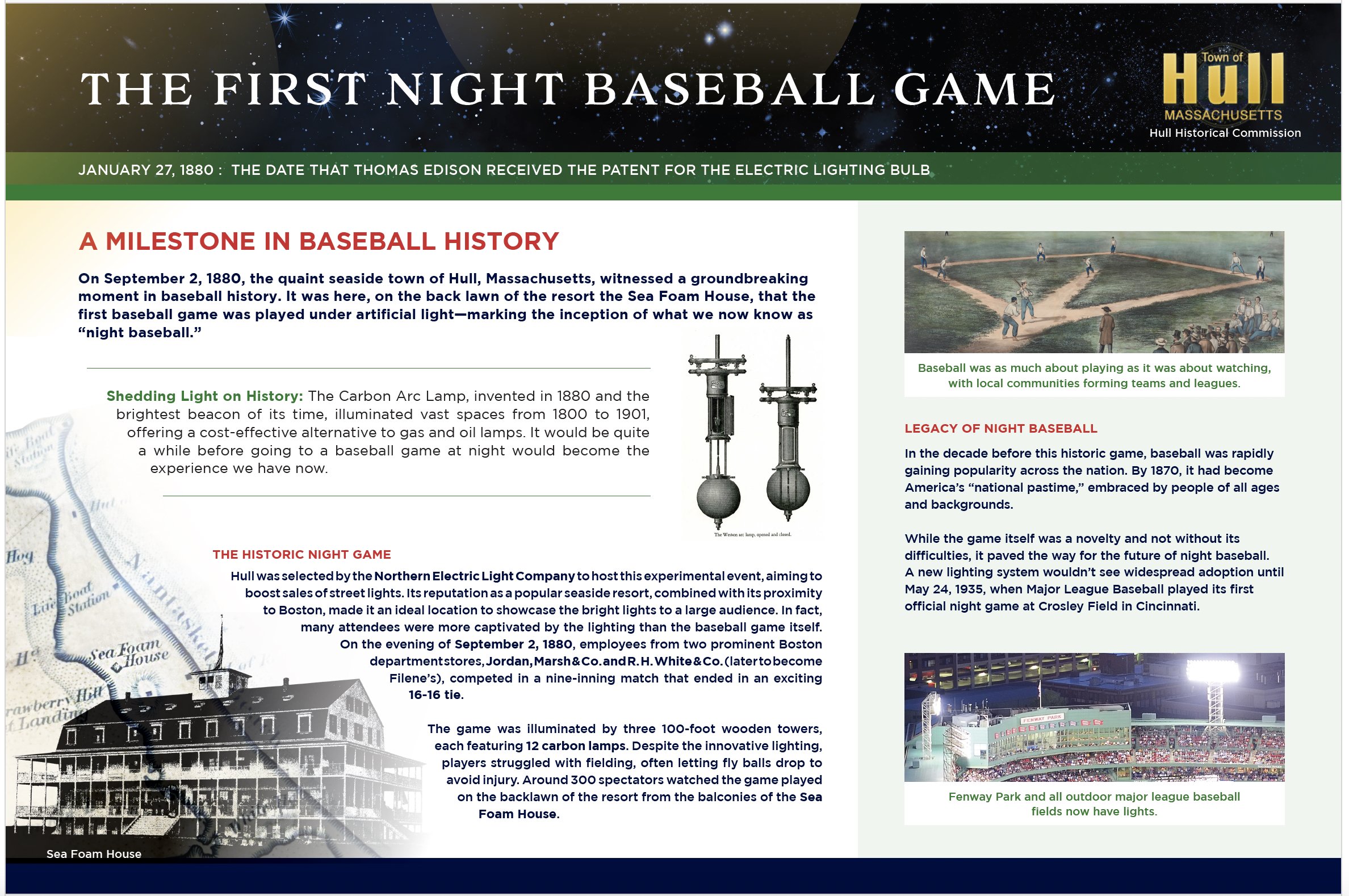They padlocked the doors to town meetings to make sure opposing voices could not be heard (one man, “Padlock” Bill Reddie, had that specific responsibility). They rigged ballot boxes. They tracked elections voter-by-voter and knew exactly who had voted for whom, so that punishments could be handed out to those who voted against the group’s agenda. Doc Bergan, who was in on the fixed elections, told the whole story. In one famous case, after ex-Mayor John “HoneyFitz” Fitzgerald of Boston lambasted the Old Ring in a public meeting, town workers showed up at his summer house at the base of Allerton Hill and dug a trench right in front of it, only filling it in after he and his family had left for the winter.
Although much can be read directly from the annual town reports – any time money went from the town budget to John Wheeler, John Smith, and others, it was a tell – we are left wondering about the inner workings of the Ring. How did they operate? Who was selected to do what? How did members get elected?
Finally, we have answers.
The Old Ring kept minutes.
An unexpected donation to the Hull Historical Society this fall contains the remarkable story of the Hull Citizens Association (the Republican Town Committee, or the “Old Ring”) from 1922 to 1939. In this record of association meetings, we can read about that catastrophic moment when John Smith passed away and how the fight to fill the void he left behind unfolded. We can see everything fall apart in 1939. And, thanks to a long list in the back of the book, we have the names of all members of the Old Ring during this 18-year period.
When the book begins, at 7:30 p.m. on February 21, 1922, at a meeting at the Hull Police headquarters on Atlantic Hill (across the street from Boss John Smith’s house; he never liked to travel very far from home), the treasurer reported a balance of $140.75 (about $2,500 today). The first order of business at the regular meetings was to elect new members. In 1922 “The names of Murdock Gillis, Walter Hastey, Daniel Sullivan, John R. Morton, and Daniel Souther were recommended by the membership committee and they were elected members of the Association by unanimous vote.” In what also was annual tradition, the president – of course, John Smith – “declared a recess prior to calling the meeting to enable those present to pay their dues to the collector,” Frank Richardson.
As the meeting continued, John Smith reclaimed the presidency for another year, Clarence Vaughn Nickerson (selectman and superintendent of the Hull Schools) and James Jeffrey (a fellow selectman) took the two vice president positions, John G. Waterhouse was named secretary, and Nickerson was named treasurer. The association had four longstanding committees during these years, although we don’t know for sure their exact responsibilities. The transportation committee consisted of seven members: Walter N. Cummings, John R. Wheeler (auto dealer), Herbert C. Huntress, George A. Dodge (owner of Paragon Park), Henry Stevens (police and fire chief), Newton Wanzer (transportation company owner) and Raymond McDonald (fire engineer, or engine driver).
The ballot committee (James Jeffrey and Andrew F. Pope) might simply have been in charge of ensuring the proper names were listed on the town election ballots every year. At worst, it could have been much more, as Doc Bergan has told us. We can only surmise. Boss Smith’s political savviness led him to not put down anything incriminating in the organization’s minutes.
The membership committee included Frank M. Reynolds (former police chief), Jeffrey, and Walter N. Cummings.
The all-important dinner committee consisted of John R. Wheeler, long known as the money man behind the Old Ring, and John W. Sweeney. We can guess, here, that there was nothing really nefarious happening with this committee, save for, possibly, finding access to booze during Prohibition and, of course, money flowing into the wrong places. But, without a paper trail, this is simply amusing historical conjecture.
The meeting then voted on a slate of town officers to be endorsed by the Association, all of whom would be elected. Interestingly, oftentimes the association held its own internal elections. When, for instance, in 1922 three internal candidates stumped for two open positions on the board of assessors, James W. Douglas polled 39 votes, Frank P. Richardson, 32, and Charles E. West (store owner at “West’s Corner”), 7. Shrewdly, Clarence Nickerson presented a motion to have member Charles McDowell “circulate papers in the interest of Mr. West.” That way, all three candidates could “run,” and if West won one of the seats, the Ring lost nothing. They still took both open seats.
The other item of real interest in 1922 – the year that the new Hull Municipal Building would open, across the street from Boss Smith’s home – was the inclusion of a woman. Although the association presented as an exclusively male club, Carrie E. Mitchell stood out. She held that coveted spot as trustee of the Public Library, so endorsed by the association for a three-year term that year. She would also take a spot on the School Committee.
We don’t know whether Carrie Mitchell smoked cigars. But, based on the minutes of February 1923, we can envision the annual meetings of the Ring as smoky affairs. For that year, the minutes include a budget: $68.90 for cigars; $16.45 for printing; $25 for transportation; $202.65 for “lunches, etc.” Cigars accounted for 22% of the annual budget.
Over the next few years, the association grew, both in membership and cigar budget. In the 1923 meeting, held in the Damon School (also basically across the street from Boss Smith’s home), the Ring welcomed 52 new members, each named individually for the vote, including members of the Bergan, Cohen, Anastos, Mitchell, Means, Eastman, and Coleman families, among others. Many represented the same families that had controlled town politics for the past 20 years, brothers and cousins of existing members. Numerous World War veterans (and at least one future World War II casualty) joined. And yet, not a single new member became either an officer of the association or a town office holder that year; those roles still fell to a select few. Perhaps membership expanded that year due to a marketing ploy. Membership dues dropped to $1 that year.
In 1924, we begin to see the seeds of change. Selectman and association Vice President Nickerson presided over the meeting, as he did over most things for the town that year. In fact, for the next three years, Nickerson took control of the annual gathering. Although John Smith’s name still stood prominently at the masthead of the organization, he was obviously absent after three decades as selectman and president of the Ring. Ambrose Burnside Mitchell, Herb Olsen, George P. Cobb, Robert Shea, Doug Ross, Charles Pitts, Clifton Jager, James Burke, James Maxwell, William S. Arnold, Adrian P. Dowd, Harold Olsen, and Herb Green joined the association in 1924. Ten more joined in 1925, including the commanding officer of the Point Allerton Coast Guard station, Captain Hilton Acker. Thirty-three new members joined in 1926, including members of the Berman, McPeak, McGonagle, Delmonico, Taurasi, Apostolu, Cadish, Brennan, and Desmond families. One name really stands out: Herb Gordon, Hingham High School class of 1925. Four years after joining the Hull Citizens Association, Gordon would become publisher of The Hull-Nantasket Times. Was it intended as a platform for advancing the agenda of the Old Ring?
John Smith’s absence became pronounced in 1926. Nearing 70 years old, Smith had affected or controlled Hull politics for most of his adult life. On August 3, 1926, the Association called an emergency meeting. Boss Smith was dead.
The association reacted as it should have. For better or worse, John Smith had been an integral part of everything that had happened in Hull for decades. The meeting voted that “Resolutions as offered by Mr. Jeffrey of our late Pres. John Smith be spread upon our records, and one copy sent to the family.” The members mourned as they should have. But a new reality arose. There was now a space at the top. At that same meeting, the members made a quick decision to fill the role of Selectman John Smith: Henry Stevens, constable, police chief and fire chief. As far as Citizens Association President John Smith’s role went, that would have to be decided at the 1927 annual meeting.
As that meeting started on February 27 in the upstairs auditorium of the Municipal Building at 8:25 p.m., procedures noticeably changed. “Voted,” read the minutes, “That all applicants to Association be asked to fill out an application blank and that the same be acted upon in their absence.” No new members were admitted that year.
Clarence Nickerson took the role of president by unanimous vote, but did he truly wield all of the power in the organization? James Jeffrey remained as one of the two vice presidents, but Henry Stevens took the other. That meant that he was now selectman, police chief, fire chief, and vice president of the association. As Nickerson had, Stevens would bide his time and wait for the opportunity to claim the number one position in the Old Ring.
More new members arrived in 1928: John Pedonti, Chester Gould, future police chief Dan Short and 11 more. In 1929, the association welcomed 37 more, and responded to several requests from members. One motion called for “3 selectmen as heretofore be the opinion of this meeting;” voices in the community were calling for an expansion of the board of selectmen, perhaps to break the logjam of Old Ring control. The meeting also voted to “go on record as opposed to Civil Service” and “in favor of gas under favorable conditions.” Such political notions increasingly became prevalent in the minutes.
On January 31, 1930, just a few months into the Great Depression and a period of troubling uncertainty, as well as following the tragic loss of the Nantasket steamboat fleet to fire on Thanksgiving Day, the association met and discussed topics such as how much the town should pay to dredge the Weir River and voted “To endorse yes on ballot at March meeting relative to Commissioner of Public Safety.” The idea, which did not pass townwide vote in 1930, was for the selectmen to appoint one of their own to this new position. Henry Stevens’ moment had nearly arrived. Although Clarence Nickerson remained president of the Old Ring, Stevens now held supreme power, as his three town roles officially would be consolidated into one. Instead of calling himself selectman, fire chief and police chief, he could simply say he was Commissioner of Public Safety. The following year, the town made it so.
The debate on Civil Service continued into 1931. Massachusetts was the second state in the nation to adopt civil service legislation, in 1885, but Hull had held out. Once the Old Ring came to power, it was out of the question. Without civil service laws, town jobs remained in the hands of the party in power. It was one piece of leverage the Old Ring held closely. During the 1931 meeting, the welfare of local families had never before been so in question. Civil service could mean the difference between poverty and at least sustainability for many Hullonians. The only obstacle standing in the way for many qualified Hull residents was the desire for patronage or payoffs by the political machine. Some members had seen enough. “After a debate between Henry J. Stevens, Wm. M. Bergan, Clarence V. Nickerson, Herbert Huntress, Dr. Sturgis, Horace G. Ettinger and Capt. Gordon + Robt. Kelly, it was voted that this association go on record as opposed to civil service.” We don’t know who spoke on which side, but based on future actions, we can argue that Doc Bergan was emerging as a voice for the working man.
In 1932, as the Depression deepened, Hull residents turned to the Old Ring for hope. While 10 new members had joined in 1931, 82 joined in a June meeting in 1932, which also featured the first itemized budget, including a $52 payment to The Hull-Nantasket Times, $40 to the Bayside Theatre for “pictures & operator,” $30 to the Murray Chocolate Co., and a mysterious $98 for “entertainers.” On August 2, 70 more members joined.
The reason for the second meeting in three months had to do with the death of James Jeffrey, longtime selectman. As with the passing of Boss Smith six years earlier, the association needed to find a replacement quickly. Four men stood for election: Dr. Walter Sturgis, Daniel J. Murphy, Robert Kelly, and Harland Skelton. President Nickerson appointed tellers and ballot clerks. Murphy took the first round, with 104 votes, but needed 140 of the 291 cast to take the endorsement for selectman. Skelton dropped out after the first ballot, having received only 28 votes. The results tightened. With 135 necessary to win, Murphy scored 111 of the 268 votes cast in the second go-round. On the third ballot, Murphy gained one vote while Kelly lost 20. He resigned for the fourth ballot. At 12:30 a.m., August 3, 1932, Daniel Murphy earned the endorsement over Dr. Sturgis. He became a selectman in 1933.
For the next three years, the Association’s business flowed smoothly; with the Depression as miserable as it was, there was little that could be done. In 1936, Murphy defeated James Bacon for the selectman’s endorsement, 119 to 16, and again took his seat on the board. The 1937 meeting featured an appearance by Hull’s own Representative John Q. Knowles, who spoke “very strongly” about his bill to spend $100,000 in state money to dredge Hull Bay as a Federal Works project. Due to a clerical error, it had been submitted as $1,000, but he assured that he was pushing for $100,000. The association voted to back his cause.
The 1938 meeting came and went quickly, with only a single round vote for a position on the park department.
That fall, two tragedies struck. First, in early September, Henry Stevens died unexpectedly, leaving the town without a commissioner of public safety. Then, a week later, the Hurricane of 1938 arrived with 121-mile-per-hour winds registered at nearby Blue Hill Observatory in Milton, with gusts up to 182. On October 6, the Association met to vote in a replacement for Stevens.
Here, the minutes get clouded. After standing in silence in honor of their lost leader and voting to draft resolutions in his memory, “We then proceeded with the nomination of candidates. C.S. McDowell was nominated by Oliver Olsen. J.E. Mitchell by Wm. Mitchell. Wm. Lyman by…” There was no name. “The following tellers were nominated:…” No names.
The ballots were tallied: McDowell, 199; Mitchell, 51; Lyman, 2; Blanks, 1. Mitchell and Lyman then did the unheard of. They resigned from the Hull Citizens Association and left the meeting. McDowell accepted the endorsement. For the first time in the minutes from 1922-1938, Secretary John Waterhouse wrote “All ballots both used and unused have been destroyed by me.”
Page 78 of the journal holds a banner across the top: “Feb 14th 1939.” There are no more words written down. A random, floating piece of paper holds the following never-spoken resolution: “To prevent any attempt to pack this or any future meeting of the Association, I move that the question of admitting new members always be considered after the endorsement of candidates. February 14, 1939.” The Association had taught its own too well. That political savviness that had made the Old Ring strong for so many years would finally come back to bite it. There was no 1939 meeting.
A few days after that planned meeting date, Doc Bergan, a former member of the Old Ring, declared he would be running for selectman opposite Dan Murphy. Edward J. Haley stood for assessor against Old Ring candidates. Bergan took to the radio to make a plea for the working man and won the election. For the first time since 1900, someone other than an Old Ring candidate sat on the board of selectmen. Haley joined him in town government, deepening the crack in the Old Ring armor.
The Old Ring was no more.
This story skims the surface of a remarkable four-decade journey. The back pages of the book lists hundreds of names of members of the association, each of whom have their own stories to tell.
The Hull Historical Society is deeply indebted to Terri Lynn Geary and family for the donation of this incredible document, which offers an unparalleled view behind the curtain of the most important local political movement in Hull history.
If you have photos and memorabilia that you would like to donate to the Hull Historical Society, email hullhistoricalsociety@gmail.com. The Society maintains an archive of historical items on the second floor of the Village Fire Station and is working toward digitizing its collection.
Like what you’re reading? Stay informed and support our work with a Hull Times subscription by clicking here.
Do you have an opinion to share? Click here to write a Letter to the Editor.
© 2025 The Hull Times. All rights reserved.


























